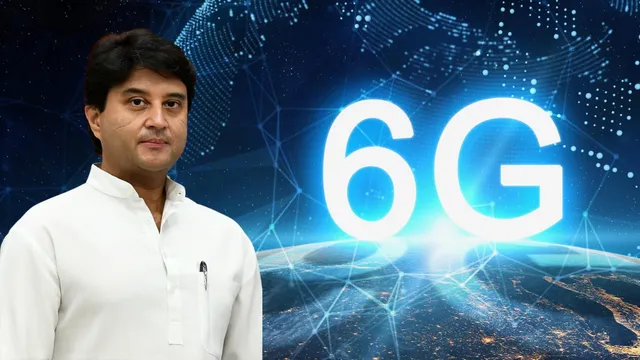- By Konark Tyagi
- Mon, 06 Oct 2025 06:09 PM (IST)
- Source:JND
In an exclusive interview, Union Minister Jyotiraditya Scindia discussed India’s burgeoning tech community across AI, semiconductors and robotics, from 6G advancement and SATcom space communications. He also shared a unique bit of personal information about his fitness strategy with the Whoop Fitness Tracker, stating that quality sleep trumps quantity of exercise.
This year's IMC conference echoes India's global digital economy leadership through its "Innovate to Transform" theme and 2025 initiative, while also emphasising India's commitment to building efficient, inclusive and technologically driven mobility solutions.
Today at the IMC 2025 we got to travel with Hon'ble Minister Jyotiraditya Scindia in Metro from Yashobhoomi Sector 25 Metro to the main IMC hall. Here is all we got to know from him in our journey and what we saw in the exhibition.
Jyotiraditya Using Whoop Fitness Tracker
When asked about his Whoop fitness band, Jyotiraditya Scindia revealed that he uses it to track various health metrics.
“I don’t use it only to measure my workout,” he said. “Quality of sleep is more important. People often forget that the secret of fitness isn’t just exercise/workouts—it’s recovery. Long hours of sleep don’t necessarily mean good recovery.”
He emphasised sleep quality, suggesting that rest and recovery are as crucial as workouts.
Turning Challenges Into Opportunities: India’s Tech Vision
Scindia highlighted how India has consistently transformed its challenges into opportunities, particularly in the tech and digital sectors.
“Under the leadership of our Prime Minister, India turned the COVID challenges into opportunities,” he stated.
This transformation is visible with several landmark initiatives:
India AI Mission – ₹10,000 Crore Budget
India Semiconductor Mission – ₹75,000 Crore Budget
These missions aim to establish India as a global tech hub, creating value across the semiconductor, AI, ML, IoT, and telecom ecosystems.
“India is now established in the value chain — from semiconductor chips to telecom carriage, applications, and AI,” Scindia said. “Different companies are adding value across the first mile, middle mile, and last mile.”
He also mentioned that with global giants like Nokia, Ericsson, Cisco, Samsung, and Qualcomm employing 20,000–30,000 professionals each in India, the nation’s technology ecosystem is stronger than ever.
6G Readiness: India’s Seat at the Global Table
As the world prepares for 6G technology, Scindia explained that India is no longer a spectator but a participant in shaping global standards.
“6G is still in the process of articulation — protocols and standards take 5–7 years to set,” he said. “For 5G, we didn’t have a seat at the table. But this time, we’ve started early.”
India’s proactive approach has already paid off:
2–3 of India’s 6G propositions (including Ubiquitous Network) have been accepted by global standard-setting bodies like ITU and 3GPP.
The Bharat 6G Alliance is driving development across seven key verticals, each tracked through detailed Gantt charts to monitor progress.
“I expect the 6G standards to be finalised by 2027–28,” Scindia added. “After that, equipment manufacturing will begin, and by 2030, we should see 6G in execution mode.”
Future Use Cases of 6G
While it’s still too early to define exact 6G use cases, Scindia emphasised that the technology will unlock multiple transformative applications once global standards are finalised.
Robotics: AI will Play Important Role
Scindia believes that Artificial Intelligence will be the primary driver of robotics in the coming decade.
“AI will be the input of Robotics,” he stated.
From robotic dogs to factory automation and precision surgeries, robotics is already finding real-world applications in India’s manufacturing and healthcare sectors.
“We’ve already seen examples like robotic dogs. Adoption will grow — in car manufacturing, chip manufacturing, and even medical surgeries,” he explained.
This AI–robotics convergence will redefine how industries operate — enhancing efficiency, precision, and productivity.
SATcom: Making its way in India’s
Another exciting development is in SATcom (Satellite Communication) — a sector that will shape India’s digital connectivity in remote and rural areas.
“The future of SATcom is bright. The pathway is already in place—regulations and licensing regimes are in process,” Scindia shared.
India has already issued three SATcom licenses, and the Minister is confident about rapid expansion.
“I’m very confident that the SATcom market should double in the next couple of years,” he said.
This aligns with India’s push toward universal connectivity, supporting applications in defense, aviation, remote healthcare, and IoT-based agriculture.
The IMC 2025 exhibition showcased emerging technologies including:
- 5G & 6G advancements
- Artificial Intelligence (AI)
- Semiconductors & Electronics Manufacturing
- Green Technology & Cybersecurity
- Quantum Computing & Smart Mobility Solutions
Government's Collaborative Effort
Specialised Summits and Conferences
IMC 2025 will host 100+ sessions and 800+ speakers across specialised summits such as:
- International Bharat 6G Symposium (with Bharat 6G Alliance)
- International AI Summit (with MeitY)
- Cybersecurity Summit (with NSCS)
- Satcom Summit (with IN-SPACe)
These sessions will explore transformative technologies shaping India’s digital and strategic future.
India's Vision for 2047
IMC 2025 is a testament to that promise and it is this vision which will help realise the “Viksit Bharat 2047” from an era of using technology for driving the economic growth, social inclusion and global leadership. The occasion is emblematic of India's digital transformation story and the integration, inclusion, innovation that it reflects.
Conclusion: Accelerating Full Tech Transformation
Jyotiraditya Scindia’s insights paint a clear picture — India is not just adopting technology, it’s shaping it.
India has an expansive digital vision that spans from artificial intelligence and semiconductors, 6G preparedness, robotics and space communication systems - to AI and semiconductors, robots and space communications systems. Led by leaders such as Scindia who spearhead initiatives geared toward innovation, skill development and sustainability; India's tech future appears more promising than ever.

